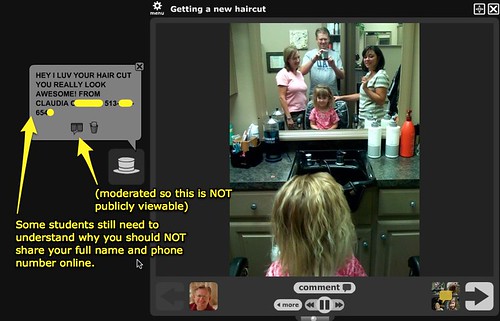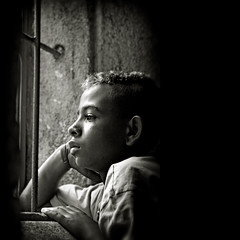It is amazing to me how many students and others continue to view and comment on Rachel’s VoiceThread digital story, “Getting a new haircut,” which she created when she was 3 years old. Most of the comments which are left are very positive. Lately, many of the comments seem to be coming from students possibly leaving their first VoiceThread comments. For students who have not participated with social media previously, this is doubtless an exciting activity. In addition to leaving audio comments, often students will also draw on photos with their mouse pen. I have comment moderation enabled for this VoiceThread because of the large volume it continues to receive. I end up approving most of the comments which are submitted. This evening, however, a student commented and left both her full name and phone number. (I’ve obscured the full name and number in this photo, however.) I didn’t approve this comment, because (of course) if I did her information would be visible to everyone.
We shouldn’t assume that all students understand Internet safety and the importance of protecting personal information (like your phone number) online. While the act of sharing a full name and phone number online may be innocuous, it also may be a cry from someone to connect and communicate.
The PBS Frontline Special from a year ago “Growing Up Online” remains one of the best television specials I’ve seen to date about the risks of the online world for troubled teens and digitally-fearful adults. I love the fact that ALL the episodes from that full program are viewable online, free. (A downloadable version is available on iTunes for $1.99.) Compared to the stories related in that special, seeing an example like this of someone sharing their name and phone number online seems like small potatoes. Eating disorders, struggles with identity, cyberbullying, underage alcohol abuse, and other issues are real and very serious. In watching the entire program, I was struck by how many dads I actually know right now who have a daughter battling anorexia, or even a son who has recently written suicide notes that were just discovered.
It is distressing and painful to learn about these societal problems, and particularly difficult when situations like these hit close to home. We live in a suffering world. We have enduring needs to connect with and support each other, and a major part of our focus in schools should be helping establish supportive learning communities where respect, understanding, and care for one another is emphasized and expected.
I am likely going to share another presentation on cyberbullying prevention and Internet safety in Watonga and Kingfisher, Oklahoma, next month, for a middle school health fair their schools have every year. In some ways I feel I have so little to offer in the way of advice and help to teens, because the issues they face are in many cases so formidible and complex any advice I have might seem quite simplistic. Yet, knowing the difficult challenges teens DO face, one of the most important messages I think I can share (and try to) is the importance of reaching out to others around us to be a friend and positively support them. It is amazing how destructive and hurtful words can be. At the same time, however, positive, encouraging words can be powerful and transformative as well.
My eight year old daughter received Shel Silverstein’s book “Where the Sidewalk Ends” this past Christmas, and we’ve been reading poems from it recently before bed. Last night we read “Listen to the Mustn’ts” and it resonated with us both:
Listen to the MUSTN’TS, child,
Listen to the DON’Ts
Listen to the SHOULDN’TS
The IMPOSSIBLES, the WON’TS
Listen to the NEVER HAVES
Then listen close to me–
Anything can happen, child,
ANYTHING can be.
The world can be a dark place, but that dark place can become abruptly brighter and warmer because of the thoughtful and caring words of a TEACHER or friend who can speak words of truth and love into that darkness.
Listen close to me. Anything can happen, child, ANYTHING can be. 🙂
Technorati Tags:
cyberbullying, bullying, safety, internet, isafety, education, school
If you enjoyed this post and found it useful, subscribe to Wes’ free newsletter. Check out Wes’ video tutorial library, “Playing with Media.” Information about more ways to learn with Dr. Wesley Fryer are available on wesfryer.com/after.
On this day..
- Tips for Self-Publishing Your Book (February 2019) – 2019
- MakerSpace Resources & Ideas for Digital Music Creation – 2016
- Digital Storytelling MeetUp with Joe Lambert: Friday, February 13 – 2015
- FREE iPad App Coffee Chats start Tuesday, February 7 in Edmond, Oklahoma – 2012
- Learning from a Master Teacher: Darren Kuropatwa #k12online – 2011
- Get ready for Sixth Sense Technologies – 2010
- Getting started video tutorials with WordPress – 2010
- Larry Lessig on the idiocy of current US copyright law – 2009
- Hank Thompson WWII Interview – 2008
- Cyberbullying: How to Deal with Hi-Tech Harrassment by Terri Pulley – 2008



Comments
2 responses to “Internet safety and our need to connect with teens”
[…] just read this article; Internet safety and our need to connect with teens by Wesley Fryer. “We shouldn’t assume that all students […]
Good post. When it comes to Internet safety, the key is parents and kids being educated. It’s no secret the Internet isn’t the safest place for kids. Fro bullies to predators to simple niavete, the threats are multiple. However, it can be safe, as long as you – as a parent – are there to watch what they do and teach them how to be safe. By teaching kids early how to be a Responsible CyberCitizen (www.responsiblecybercitizen.com), there is a better chance of them staying safe through their teen years and beyond. And by monitoring their online activity with parental control monitoring software like PC Pandora (www.pcpandora.com) you will know if they are safe, and will have records of their activity to start a conversation on their actions.
I’d like to learn a bit more about your Internet safety presentations – can you email me at the supplied address?